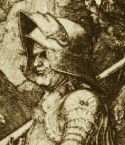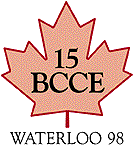
Symposium On Integrating Computers into the Undergraduate Chemistry Curriculum.

Part of The Alchemist's
Lair Web Site
Maintained by Harry E. Pence, Professor of Chemistry, SUNY Oneonta, for
the use of his students. Any opinions ar
e totally coincidental and have
no official endorsement, including the people who sign my pay checks. Comments
and suggestions are welcome (pencehe@oneonta.edu).
Last Revised July 6, 1998
 15th Biennial Conf. on Chemical Education
15th Biennial Conf. on Chemical EducationOrganizer and Presider: Harry E. Pence
10:00 Introductory Remarks
10:05-211 What should students know about com puters. Mary L. Swift, Theresa Julia Zielinski
10:30-212 The costs of integrating computers in the chemistry curriculum. Brian Tissue
10:55-213 The integrated circus: A seven-step guide to the coalescence of computers and chemistry. Betty A. Luceigh,
11:20-214 Development of web based materials for cooperative laboratories. Melanie Cooper, T.S. Kerns
11:45-215 Collaborative computational experiments in physical chemistry laboratory. David N. Whi snant, Jerry J. Howe, Lisa S. Lever
Presiding: Abby Parrill (University of Memphis)
2:00-263 Computer animations at the particulate nature of matter level. Thomas J. Greenbowe
2:25-264 Studio Chemistry: The integration of technology, laboratory, and learning in general chemistry. Christina A. Bailey, Jeffrey Paradis, Kristen Kulinowski
2:50-265 Incorporating computational chemistry and molecular modelin g into the curriculum: The short version of a very long story. Abby Parrill, James F. Harrison
3:15-266 Advanced features of MoluCAD, molecular modeling program for organic chemistry. Joseph W. LeFevre
3:40-267 Integrated molecular modeling, synthesis, and characterization laboratories for inorganic chemistry. Karen J. Brewer, Michael R. Jordan, Elizabeth Bullock
Presiding: Elizabeth T. Bell-Loncella (Univer sity of Pittsburgh at Johnstown)
10:00 Introductory Remarks
10:05-445 Using multimedia-based immersive environments to teach introductory chemistry. Marco Molinaro, A. Stacey, Susan Kegley
10:30-446 A web-CD hybrid distributed learning general chemistry course. William J. Vining, Rebecca Penniman, Patrick Harman, Debra L. Wirkman, Regina Pierre, Barbara A. Price
10:55-447 Teaching chemistry with technology: Strategies for bridging the gaps. James H. Re eves, Charles R. Ward
11:20-448 Computer mediation of a first year chemistry laboratory program. John C. O'C. Young
11:45-449 LUCID: Computer-based activities for in-class team learning. Troy Wolfskill, David M. Hanson
Presiding: Diane D. Wolff (Ferrum College)
2:00-490 The use of TI-83 calculators, CBLs, and computers at Ferrum College. Diane D. Wolff, Carrol Rabon
2:25-491 Computer exercises for point gro ups. Margaret E.. Kastner, Patrick Leary, Jonathan Greives, Keith DiMarco
2:50-492 With MAPLE thermodynamics is easy. Kathleen Tremblay, M. Scarlete
3:15-493 A computerized classical general chemistry laboratory. R.W. Kluiber
3:40-494 Using a Web Browser as a presentation manager. Scott Van Bramer
*********************************End of symposium*****************
For more extensive information and the complete program, go to the BCCE Website. or request a copy of the program by e-mail from bcce@uwaterloo.ca
Return to The Alchemist's Lair Web Site
You are the visitor to the Alchemist's Lair site since Jan. 10,1997.